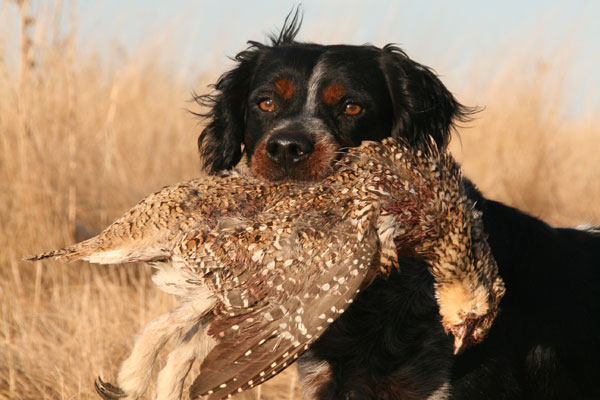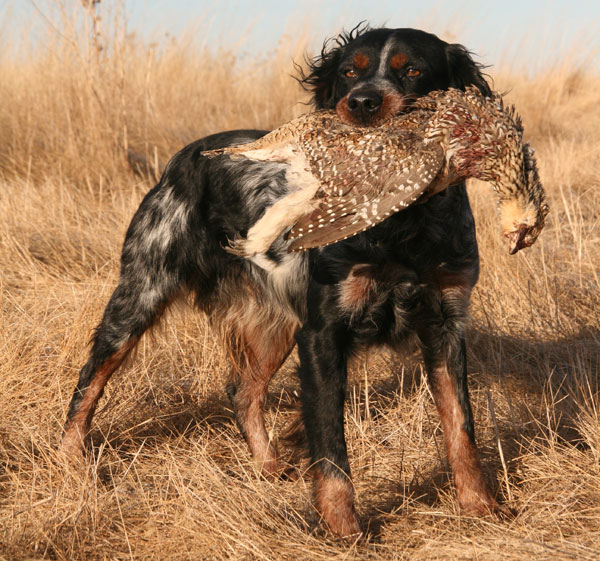
If your little dog can find that goose, you can keep the bird," the waterfowl hunter told Doug Lodermeier, who, along with Elsie, his 6-year-old, 28-pound French Brittany, and Derek Lodermeier, his son, had been hunting pheasants a quarter-mile from a corn stubble field full of decoys.
The goose was a big Canada honker that after being shot and wounded had set its wings into a half-mile long glide and landed in the middle of a 100-acre field of head-high prairie grass.
Elsie and the two Lodermeiers took off in the general direction of where the big goose had gone down. Arriving at the field, the little French Brittany worked the cover in a classic zig-zag fashion, appearing only occasionally as she ran through the thick and tall vegetation.
"I can hear her barking," Derek said to his dad as they both closed in on where Elsie was raising a ruckus. "There was the huge honker with its wings flapping and its outstretched head hissing as Elsie lunged at the bird and looked for some way to grab it," Lodermeier later reported. A minute later, the big goose was subdued and dispatched and the hunters and the little dog resumed their search for pheasants.
This wasn't the first Canada goose Elsie had encountered, because, as Lodermeier says, "On a couple of occasions she had retrieved honkers that had fallen in open water. Bringing in one of the big birds while it's floating is no big deal for most any dog. But finding a live one hiding in a big tract of high and heavy vegetation—well, that's a more significant accomplishment, especially for a little dog doing this dry land hunt for the first time. And particularly when the moose of a goose weighs nearly 10 pounds and the squirt of a canine tips the scale at a little under 30 pounds."
That Elsie was a competent waterfowl hunter was originally something of a surprise to Lodermeier because he had bought the little French Brittany for different reasons. "I wanted a gun dog that at an early age would naturally search for, point, and retrieve pheasants, prairie grouse, ruffed grouse and woodcock. And I needed a little dog that would be easy to keep in our small house in the big city setting," Lodermeier says.
"No 70-pound German shorthair or 90-pound Labrador would do in our neighborhood where everyone lives 25 feet from each other. In addition, I was after a civilized companion animal that would not require lots of space in our home or in the yard."
Size Matters
"What a cute puppy!" is something Linda Bradford hears all the time when strangers first see Jack, her 8-year-old French Brittany. At 34 pounds and standing knee-high to Bradford, the little dog does have a puppy-like look that makes him welcome at the dog park where he is regularly exercised or when he is walked down the street close to home.
"Before I got Jack, I had a 100-pound golden retriever who was pretty intimidating everywhere we went so that other people with dogs would go across the street to avoid us," Bradford says. "Not so with Jack because of his small size and non-threatening appearance."
Jack is no little wimp, however, Bradford is quick to make clear. "On a woodcock and ruffed grouse last season, one of my hunting buddies brought along his big 2-year-old male Drahthaar," she recalls. "There was the usual nose touching and butt sniffing, followed by the Drahthaar hovering over Jack in an aggressive posture. Jack growled, snarled and snapped, putting the bigger dog in its place and delivering a message without a fight."
Out in the woods, both dogs hunted together comfortably, honoring each other's points and retrieving birds without any disruptive competition. "Jack may look like a puppy, but he hunts like any dog twice his size," Bradford relates.
Training Temperament
"Some French Brittanys can be drama queens when training pressure is applied," notes Jim Keller from Keller Gun Dog Kennels near Lincoln, Neb. "By 'drama queen' I mean this breed sometimes tends to overreact with a lot of emotional outbursts when specific behavior is required of them.
"For example, when being taught to force fetch, some French Brittanys will squeal and squirm in an effort to get the trainer to leave them alone. And some trainers will back way off and let the dog have its way," Keller says.
"When I see this overreaction coming, I just lower the level of pressure and increase the repetition of lessons until the drama queen comes to realize that what I'm expecting isn't all that big a deal. This kind of patience and persistence pays off because these dogs are usually very intelligent, and once they understand the logic of the lesson being taught, they will quickly get with the training program."
The same caution about pressure, repetition and logic is necessary when using an e-collar on this breed. Go slow and easy and make sure you have succeeded with conventional hands-on teaching methods before adding the e-collar to enforce training lessons. "Once a French Brittany understands and accepts the rules, more sophisticated training comes pretty easy," Keller says.
"Most of the French Brittanys I've seen are precocious in that a pup born in early spring will readily take to training all summer and will be ready to hunt that fall," Keller concludes. "Don't expect an adult dog performance of course, but do anticipate a dog that will find, point and retrieve pheasants, quail, grouse and woodcock. And if trained on fetching birds out of water, most French Brittanys find and bring in a duck anywhere it falls."
Proven Commodity
The first time Keith Houghton took his 5-month-old French Brittany on a first-day-of-the-season hunt, the little dog pointed three ringneck roosters, five bobwhite quail and one rare Kansas prairie chicken. When Houghton went over to a cattle pond to give the dog a drink, he flushed and shot a drake mallard that dropped in the middle of the 75-foot wide, 6-foot deep dugout. "Now what am I going to do?" Houghton wondered.
His young French Brit answered that question by charging into the water, swimming out to the bird, grabbing it, then delivering it to Houghton's hand like she had been doing this sort of thing for many years. "I've seen precocious dogs before and knew that sometimes this early indication of talent doesn't last as the dog gets older," Houghton recalls. "But in this case, this dog just got better as she matured."
"Maybe all French Brittanys aren't like this, but the half-dozen I have had in the past 20 years have all been this way," Houghton says. They get to prove themselves hundreds of days each year at Houghton Ringneck Ranch Hunting Lodge, close to the town of Tipton in western Kansas.
Finding A French Brittany
"There are three things I recommend to anyone wanting any age of French Brittany," says Mark Dinsmore, a French Brittany breeder from Star of the North French Brittany Kennels in North Dakota. "First of all, look for a close 'French connection' in the breeding of any for-sale dog.
"By that I mean a pedigree that shows a recent relationship to brood stock from the European continent in general and France in particular. The reason for this is that Brittanys from the Continent are most likely to have almost all the original genetics that make this breed so well adapted to the North American gamebird hunting environment.
"A second recommendation is to look for lines of French Brittanys that have high scores in formal hunt tests, both in their European roots and their North American background," Dinsmore continues. "I test my dogs through the UKC system, which examines and scores on several levels of natural ability and finished performance in the field. Other French Brittany breeders run their dogs through NAVHDA and AKC hunt tests as ways to prove the hunting instincts and trainability of their dogs.
"A third consideration in searching for a French Brittany of any age is personally seeing the parents at work in the field in order to get a clear impression of how they hunt. Though most French Brittanys are expected to naturally point, track, retrieve and adapt to every kind of gamebird being hunted, there are some lines that will run bigger for hunting prairie grouse or work closer when hunting woods grouse. The way the parents naturally hunt will usually show up in the pups," Dinsmore says.
"A lot of the fun in hunting with these little dogs is seeing how they don't know that they are so small," says Doug Lodermeier when he tells stories of his French Brittany, Elsie. "She's tracked a wounded pheasant a quarter-mile through soggy cattail sloughs then caught the bird and carried it all the way back to where I was waiting. And she's retrieved wood ducks out of beaver ponds where the brushpiles were so thick we couldn't see the bird or the dog for nearly 15 minutes.
"When hunting early-season prairie grouse last year, Elsie was the only dog with enough stamina out of a pack of big German shorthairs and English setters to last all day in 80-degree temperatures."
At home, this rugged little French Brittany turns from a canine dynamo into a gentle house dog. "She might bark a few times if someone rings the door bell," Lodermeier says, "but otherwise she calmly and quietly sits next to me on the couch while we watch television."







